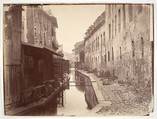La Bièvre
Charles Marville French
Not on view
As the official "photographer of the city of Paris," Charles Marville was charged with documenting the massive transformation of the city brought about by Napoleon III and his city planner, Baron Haussmann. In the early 1850s the Emperor proposed a network of grand boulevards that would plow through the narrow winding streets and overcrowded slums of Paris. Marville methodically recorded the streets and buildings slated for demolition, preserving an image for future generations.
Although we may now look back at pictures like this one with nostalgia for a lost Paris, to Marville and his audience such scenes evoked a less bucolic reality-the Bièvre was essentially a waste system for twenty-four tanneries, twenty-one leather factories, nine starch and three dye manufacturers, a paper mill, two cotton and two flour mills, four laundries, a soap and candle factory, and assorted other industries. Shortly after Marville made this photograph, the Bièvre was simply covered over and tied into the Paris sewer system.
One motivation for Napoleon III's urban plan was to ease military movement and make it more difficult for revolutionaries to barricade narrow streets and control sections of Paris, but many of his efforts were genuinely geared toward transforming Paris into a safer, healthier, more modern city.
This image cannot be enlarged, viewed at full screen, or downloaded.

